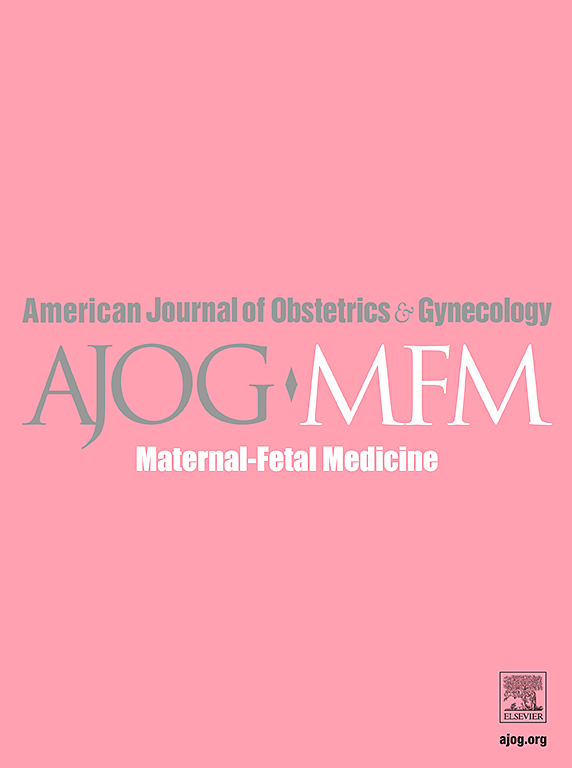孕期前三个月体育锻炼水平与围产期结果之间的关系。
IF 3.8
2区 医学
Q1 OBSTETRICS & GYNECOLOGY
American Journal of Obstetrics & Gynecology Mfm
Pub Date : 2024-10-28
DOI:10.1016/j.ajogmf.2024.101534
引用次数: 0
摘要
目的孕期体育锻炼可降低孕产妇和新生儿不良预后的风险。本研究通过凯撒体力活动调查(Kaiser Physical Activity Survey,KPAS)的评分来评估怀孕头三个月的体力活动与围产期不良预后之间的关系:研究设计:这是一项前瞻性队列研究的二次分析,患者在每个孕期都接受了 KPAS 评估。主要结果为新生儿出生体重、胎龄过大(LGA)和胎龄过小(SGA)。次要结果是新生儿综合发病率(pH值≥75百分位数和th百分位数的新生儿酸血症)。多变量逻辑回归用于调整混杂因素:本次分析共纳入了 1,045 名孕期前三个月 KPAS 评分完整的患者,其中 262 名患者在孕早期的体力活动水平处于前四分位数。怀孕前三个月较高的体力活动水平与较高的出生体重(3191.3 ± 696.1 vs 3076.3 ± 719.8 g,p=0.03)相关,但在临床上并无显著差异,SGA(10.3% vs 13.3%,p=0.25,aRR 0.79;95% CI 0.52-1.16)或 LGA 新生儿(8.0% vs 7.3%,p=0.80,aRR 1.14;95% CI 0.68-1.81)的比例也无差异。体力活动水平越高,新生儿综合发病率越低(8.4% 对 15%,P=0.80):妊娠头三个月较高水平的体力活动与较高的出生体重、较低的新生儿综合发病率和妊娠高血压有关。本文章由计算机程序翻译,如有差异,请以英文原文为准。
The association between first trimester physical activity levels and perinatal outcomes
Objective
Physical activity in pregnancy decreases the risk of adverse maternal and neonatal outcomes. This study evaluates the association between first trimester physical activity, assessed by Kaiser Physical Activity Survey (KPAS) scores, and adverse perinatal outcomes.
Study design
This is a secondary analysis of a prospective cohort study in which patients were administered the KPAS in each trimester. The primary outcomes were birthweight, large for gestational age (LGA), and small for gestational age (SGA) neonates. Secondary outcomes were composite neonatal morbidity (neonatal acidemia with pH<7.1, hypoxic ischemic encephalopathy, mechanical ventilation, hypoglycemia, and suspected sepsis), gestational diabetes, gestational hypertension, preeclampsia, inadequate and excess gestational weight gain. Outcomes were compared between patients with and without high physical activity levels during early pregnancy, defined as 1st trimester KPAS scores ≥75th percentile and <75th percentile, respectively. Multivariable logistic regression was used to adjust for confounders.
Results
A total of 1,045 patients with a complete 1st trimester KPAS were included in this analysis and 262 patients were in the top quartile of physical activity levels in early pregnancy. Higher physical activity levels in the 1st trimester were associated with numerically but not clinically significantly higher birthweights (3191.3±696.1 vs 3076.3±719.8 g, P=.03) with no difference in rates of SGA (10.3% vs 13.3%, P=.25, aRR 0.79; 95% CI 0.52, 1.16) or LGA neonates (8.0% vs 7.3%, P=.80, aRR 1.14; 95% CI 0.68, 1.81). Higher physical activity levels were associated with decreased rates of composite neonatal morbidity (8.4% vs 15%, P<.01, aRR 0.59; 95% CI 0.37, 0.89) and gestational hypertension (6.5% vs 12.9%, P<.01, aRR 0.56; 95% CI 0.33, 0.89). Gestational weight gain and the incidence of gestational diabetes and preeclampsia were similar between groups.
Conclusion
Higher levels of physical activity in the first trimester are associated with higher birth weights and lower rates of composite neonatal morbidity and gestational hypertension.
求助全文
通过发布文献求助,成功后即可免费获取论文全文。
去求助
来源期刊

American Journal of Obstetrics & Gynecology Mfm
Medicine-Medicine (all)
CiteScore
7.40
自引率
3.20%
发文量
254
审稿时长
40 days
期刊介绍:
The American Journal of Obstetrics and Gynecology (AJOG) is a highly esteemed publication with two companion titles. One of these is the American Journal of Obstetrics and Gynecology Maternal-Fetal Medicine (AJOG MFM), which is dedicated to the latest research in the field of maternal-fetal medicine, specifically concerning high-risk pregnancies. The journal encompasses a wide range of topics, including:
Maternal Complications: It addresses significant studies that have the potential to change clinical practice regarding complications faced by pregnant women.
Fetal Complications: The journal covers prenatal diagnosis, ultrasound, and genetic issues related to the fetus, providing insights into the management and care of fetal health.
Prenatal Care: It discusses the best practices in prenatal care to ensure the health and well-being of both the mother and the unborn child.
Intrapartum Care: It provides guidance on the care provided during the childbirth process, which is critical for the safety of both mother and baby.
Postpartum Issues: The journal also tackles issues that arise after childbirth, focusing on the postpartum period and its implications for maternal health. AJOG MFM serves as a reliable forum for peer-reviewed research, with a preference for randomized trials and meta-analyses. The goal is to equip researchers and clinicians with the most current information and evidence-based strategies to effectively manage high-risk pregnancies and to provide the best possible care for mothers and their unborn children.
 求助内容:
求助内容: 应助结果提醒方式:
应助结果提醒方式:


